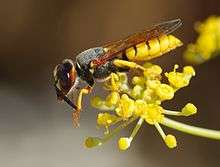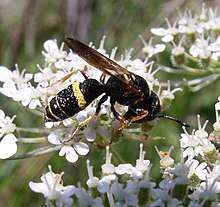Beewolf
Beewolves (genus Philanthus), also known as bee-hunters or bee-killer wasps, are solitary, predatory wasps, most of which prey on bees, hence their common name. The adult females dig tunnels in the ground for nesting, while the territorial males mark twigs and other objects with pheromones to claim the territory from competing males.
| Philanthus | |
|---|---|
 | |
| European beewolf (Philanthus triangulum) | |
| Scientific classification | |
| Kingdom: | Animalia |
| Phylum: | Arthropoda |
| Class: | Insecta |
| Order: | Hymenoptera |
| Family: | Crabronidae |
| Tribe: | Philanthini |
| Genus: | Philanthus (Fabricius, 1790) |
| Type species | |
| Philanthus coronatus (Thunberg, 1784) | |
As with all other sphecoid wasps the larvae are carnivorous, forcing the inseminated females to hunt for other invertebrates (in this case bees), on which she lays her eggs, supplying the larvae with prey when they emerge. The adults consume nectar from flowers.
The prevalent European species, P. triangulum, specializes in preying upon honey bees, thus making it a minor pest for beekeepers. Other Philanthus may specialize in other bee species or they may be generalists which prey upon a wide variety of bees such as the American bumblebee, Bombus pensylvanicus,[1] or other hymenopterans.[2][3]
They are notable in stinging their prey in a membranous location on the ventral surface where the venom quickly paralyzes major voluntary muscles, yet does not kill the prey. The prey may attempt to sting in return, but it is always grabbed in such a way that only well-armored portions of the beewolf's body are presented. The beewolf carries the prey back to a tunnel, but usually only stores it temporarily, until it is later used to provision a cell burrow, where an egg is laid.[3]
The tunnel of Philanthus triangulum can be as much as 1 m long. The first part of the tunnel slopes downward at an angle of 30° after which it levels out. Up to 34 lateral tunnels each ending in a brood chamber branch off from the main tunnel. Each brood chamber is stocked with one to six honeybees.[3]
Species
The genus Philanthus contains about 135 species,[4] including:[5][6]
- Philanthus albopilosus (syn. P. simillimus)
- Philanthus arizonicus
- Philanthus banabacoa
- Philanthus barbatus
- Philanthus barbiger
- Philanthus basilaris
- Philanthus bicinctus – bumblebeewolf
- Philanthus bilunatus
- Philanthus boharti – Bohart's beewolf
- Philanthus coarctatus (syn. P. niloticus)
- P. c. coarctatus
- P. c. raptor – robber philanthus
- P. c. siculus
- Philanthus coronatus – crowned philanthus
- P. c. coronatus
- P. c. orientalis
- Philanthus crabroniformis
- Philanthus crotoniphilus
- Philanthus elegantissimus
- Philanthus fuscipennis
- Philanthus gibbosus
- Philanthus gloriosus
- Philanthus histrio
- Philanthus inversus
- Philanthus lepidus
- Philanthus levini – Levin's beewolf
- Philanthus loeflingi – Loefling's beewolf
- Philanthus michelbacheri – Michelbacher's beewolf
- Philanthus multimaculatus
- Philanthus nasalis
- Philanthus neomexicanus
- Philanthus occidentalis
- Philanthus pacificus
- Philanthus parkeri – Parker's beewolf
- Philanthus politus
- Philanthus psyche
- Philanthus pulchellus
- Philanthus pulcher
- Philanthus sanborni – Sanborn's beewolf
- Philanthus saxigenus
- Philanthus schusteri – Schuster's beewolf
- Philanthus sculpturatus
- Philanthus serrulatae (syn. P. siouxensis)
- Philanthus solivagus
- Philanthus stygius
- P. s. stygius
- P. s. atronitens
- Philanthus tarsatus
- Philanthus triangulum – European beewolf
- Philanthus variegatus
- Philanthus ventilabris
- Philanthus ventralis (syn. Ococletes ventralis)
- Philanthus venustus
- Philanthus zebratus
Gallery
.jpg) Philanthus sp. capturing prey
Philanthus sp. capturing prey European beewolf carrying a honeybee to its tunnel
European beewolf carrying a honeybee to its tunnel

See also
References
- Williams, Paul H. (2014). Bumble Bees of North America : An Identification Guide. p. 208.
- Yeo, P.F. & Corbet, S.A. Solitary wasps. Naturalists Handbooks 3. The Richmond Publishing Co. Ltd, 1995, 2nd ed.
- Piper, Ross (2007). Extraordinary Animals: An Encyclopedia of Curious and Unusual Animals. Greenwood Publishing Group.
- Kroiss, J., et al. (2010). Male territoriality and mating system in the European beewolf Philanthus triangulum F.(Hymenoptera: Crabronidae): evidence for a “hotspot” lek polygyny. Journal of Ethology 28(2), 295-304.
- Philanthus. Archived 2014-11-01 at the Wayback Machine WaspWeb. Iziko Museums of South Africa.
- Philanthus. Fauna Europaea.
External links
- Semiochemicals of Genus Philanthus. Pherobase.
- Philanthus. BugGuide.net